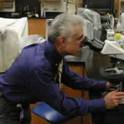Article
Interaction of Pseudomonas aeruginosa with Human Lung Fibroblasts: Role of Bacterial Elastase
American Journal of Respiratory Cell and Molecular Biology
(1992)
Abstract
Colonization of cell surfaces by Pseudomonas aeruginosa is mediated by bacterial adherence, which, in turn, is influenced by both host and microbial factors. Previous studies with this organism suggest that elastase contributes to tissue invasion and necrosis. We studied the effects of Pseudomonas elastase (PE) on the adherence of P. aeruginosa to human lung fibroblast monolayers. Treatment of fibroblasts with PE (1 µg/ml or 0.06 U/ml) increased adherence of 35S-labeled P. aeruginosa to cells, but heat-inactivated PE did not affect bacterial adhesion. Immunocytochemistry of cultured cells showed that PE (0.06 to 0.63 U/ml) decreased fibronectin (Fn) on the cell surface and extracellular matrix of cultured human lung fibroblasts. Data obtained by cytofluorography indicated that elastase also decreased Fn receptors on fibroblasts. Additional evidence for Fn degradation was provided by SDS-PAGE analysis of soluble Fn and proteins from surface iodinated cell monolayers treated with PE. We conclude that the increased bacterial adherence to fibroblasts may be due, in part, to elastase-induced proteolysis of Fn and its receptors on cell surfaces. Degradation of Fn could thus influence the extent and course of Pseudomonas infection in the lungs.
Keywords
- membrane receptor,
- adhesion,
- cell culture,
- fibroblast,
- proteolysis,
- fibronectin
Disciplines
Publication Date
1992
DOI
http://www.atsjournals.org/doi/abs/10.1165/ajrcmb/6.6.652?journalCode=ajrcmb
Citation Information
Azghani, A.O., Kondepudi, A.Y., and Johnson, A.R. 1992. Interaction of Pseudomonas aeruginosa with human lung fibroblasts: role of bacterial elastase. Am. J. Respir. Cell and Mol. Biol. 6: 652-657.
